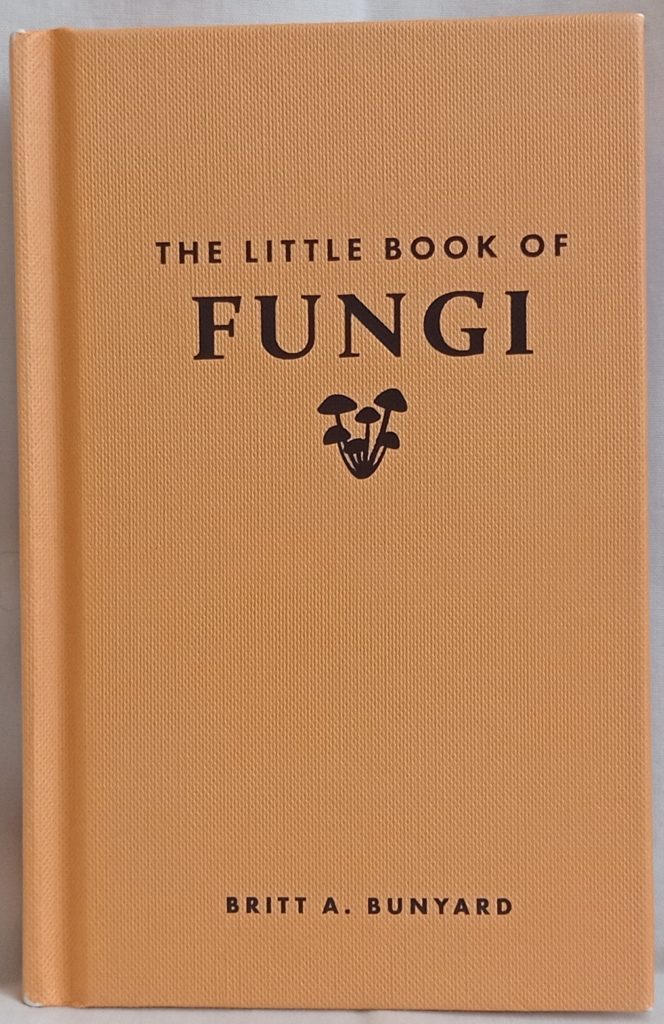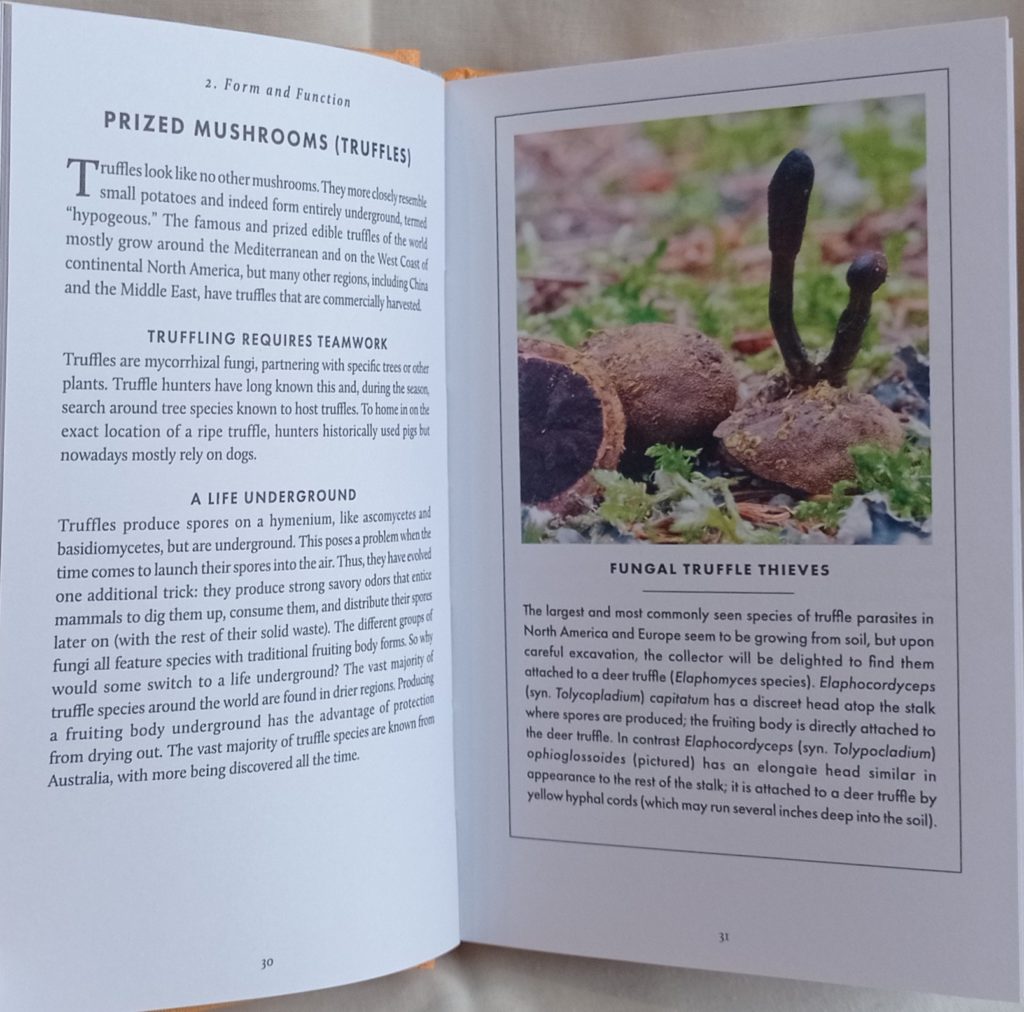
The Little Book of Fungi
Britt A. Bunyard
Princeton University Press
Published 22nd Oct 2024
160 pages
ISBN 9780691259888
The Little Book of Fungi is a new addition to the natural history series that includes The Little Book of Trees, with this one written by American academic and mycology enthusiast Britt A. Bunyard. The author spent many years studying interactions between fungi and other organisms, founded the journal Fungi, and is involved with organising the annual Telluride Mushroom Festival in Colorado. His latest book may be ‘little’ but it packs in a lot of fascinating information, and manages to convey the importance of gaining a greater understanding of these weird and wonderful lifeforms.
The first few chapters define what fungi are and cover the different forms they take, as well as their ecology, evolution, lifestyle and reproduction. The language is a little technical in places, for example some of the terms used to classify fungi and describe their reproductive structures are likely to be unfamiliar to lay readers. However it becomes more user-friendly as the book progresses on to topics such as their cultivation, conservation, roles in disease and medicine, and contribution to popular culture. Each double page spread addresses a specific topic in short headed paragraphs, illustrated with a labelled drawing or photograph, making the book easy to dip into. As suggested by The Well-Read Naturalist, the pocket-sized books in this series make a healthy alternative to social media-scrolling for filling a few spare minutes.
The most striking overarching message of The Little Book of Fungi is how prevalent, diverse, fundamental to life and under-appreciated fungi are, with the latter possibly due to the microscopic size and hidden habitats of the majority of species. It is noted that we have named only about 100,000 of the estimated 1.5 million total species of fungi. Their wide-ranging lifestyles include digesting organic matter (saprobic fungi), living symbiotically with other types of organism (eg. mycorrhizas and lichens, and many beneficial fungal-animal associations), existing as parasites (eg. economically-important plant pathogens), and even preying on animals (carnivorous fungi).
Some fungal species exist as single cells whereas most form long strands of hyphae that clump together into mycelium. They can reproduce either asexually, making a clone of the parent, or sexually by producing spores that germinate and fuse with the hypha of an opposite mating type. The most recognisable parts of a fungus, such as mushrooms and brackets on trees, are produced for the sole purpose of spore distribution. In basidiomycetes, the spores are forcefully ejected from gills, pores or spines and carried away by the wind. This process requires moisture but is disrupted by too much water, which is why many mushrooms are umbrella-shaped. The other main type of ‘higher’ fungi, ascomycetes, use a different mechanism to squirt spores out of specialised pouches. Their reproductive structures consequently have different shapes, such as the honeycomb-like caps of morels.
Many other strategies have evolved for spore dispersal, for example truffles emit pheromone-like chemicals that entice animals to dig them up (one advantage of this completely underground lifestyle is that it protects the fruiting bodies from drying out, enabling them occupy desert habitats). Another type of truffle forms small brightly-coloured ‘berries’ on the forest floor, tricking birds into carrying them away. Stinkhorns are well-named for the odour they produce to attract flies as spore dispersers, whereas the descriptive bird’s nest fungus utilises raindrops to eject packets of spores from a small cup. A trailing cord of hyphae snags on the nearest twig, maintaining its tree canopy habitat.


Many of the woodland fungi that we are familiar with, such as chanterelles and boletes, are mycorrhizal fungi that form intimate associations with tree roots, dramatically increasing the available surface area for water and nutrient uptake from the soil. The fungi in return receive sugars produced by the tree through photosynthesis. Endomycorrhizal fungi, described here as ‘the puppet masters for all life on terrestrial earth’, actually penetrate and form highly branched structures within the tree root cells. Mycorrhizal associations date back 460 million years and enabled plants to first colonise land. A short section on the ‘wood wide web’ relates the popular idea that mycorrhizal networks enable trees to communicate and support each other with shared resources, although the evidence for these functions is currently a matter of debate. There is certainly still much to be learned, for example the author highlights the Ash Bolette, which was thought to be mycorrhizal but is now known to form a symbiotic relationship with an aphid that itself parasitizes tree roots. It’s a strange and complex underworld.
Fungi are also essential in forest ecosystems for breaking down dead wood. Their unusual ability to digest cellulose (brown rot fungi) and lignin (white rot fungi) enables the resulting material to be consumed by other organisms such as wood beetles and wasps, which often bring their own supply of fungi in specialised pockets. It’s possible for living trees to survive for many years with fungi digesting their heartwood, as long as they are healthy enough to prevent access to their functional tissues. One group of fungi can even break down material containing keratin such as animal horn. It is noted that the invaluable decomposing functions of fungi unfortunately also make them a serious threat to man-made structures built from natural materials, and that the formation of fossil fuel deposits was only possible because it pre-dated the evolution of fungi that digest cellulose and lignin.
Many types of fungi such as rusts and blights are parasites of plants, and some of these can have catastrophic effects on agricultural and forestry crops. Rusts have complex lifecycles with multiple spore stages that require different plant hosts, providing some opportunities for disease control. However the Roman strategy of sacrificing dogs to save their crops from Wheat Stem Rust was probably less successful. Late Blight disease caused the Irish potato famine following the arrival of Phytophthora infestans in the 1800s, but we managed to gain the upper hand with fungicides and resistant potato varieties. Somewhat worryingly, while the fungus was only able to breed asexually at that time, its second mating type was introduced to Europe in the 1980s, potentially enabling the development of varieties that can evade our control measures.
Ergotism is a serious human affliction resulting from fungal infection of cereal crops, with symptoms including skin tingling, paralysis, convulsions and hallucinations. Historical outbreaks were linked to hysteria and accusations of witchcraft, thankfully modern cleaning methods remove ergots from the grain before it is milled. Amphibians are not being so lucky, with dramatic population declines across the world caused by chytrid fungi covering their skin. These primitive fungi are unusual in producing spores that can actively move, propelling themselves through water to find new hosts. Different types of fungi living on our skin can cause the less serious conditions of ringworm and athlete’s foot.


On the plus side, we have found many positive uses for fungi. For example it was discovered that the cancer drug Taxol, which was obtained from yew trees, is actually produced by a fungus living within the tree. Aspergillus species provide us with fermented foods such as miso and soy sauce, and are a major source of the citric acid used in the manufacture of many foods and drinks. Researchers are investigating the psychoactive product of Psilocybe mushrooms to develop a new treatment for depression, fungal mycelium is being turned into sustainable materials, and fungi that trap and digest nematodes can provide an alternative to agrochemicals for crop protection. The author also highlights a protein called glomalin, produced by mycorrhizal fungi, that could make a vital contribution to increasing soil stability and carbon storage, and describes potential benefits from ‘rewilding’ our agricultural system with ancestral microbes that have been lost though plant domestication.
The final chapter on Curious Facts includes aptly-named Titan mushrooms which form an underground partnership with termites and can produce mushrooms that are three feet wide, contrasted with tiny microsporidia that live their entire lives within the cells of other organisms. Also featured are unusual underwater mushrooms and fungi that induce plants to produce ‘pseudoflowers’ and so dupe insects into carrying away their spores. Not to be outdone in the mimicry game, a type of orchid in the cloud forests of Central America has flowers that look and smell just like mushrooms.
All of this and a great deal more is covered in this Little book, making it an absorbing read for anyone with more than a passing interest in fungi. The contents understandably have a North American bias, but the principles of fungal ecology, form and function are globally-applicable and many fungal species are (increasingly) found worldwide. The planting of non-native tree seedlings also introduces their mycorrhizal fungi – fly agaric has spread from Europe to South America in this way. What is clearly apparent from the book is that we still have a lot to learn about the many functions of fungi, and that it would be in our best interests to discover as much as possible in a timely manner.